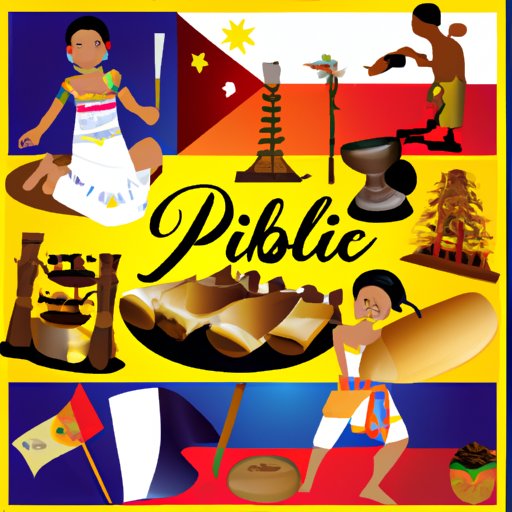Introduction
Filipino culture is a unique blend of Eastern and Western influences. It has been shaped by centuries of colonialism, occupation, immigration, and cultural exchange. This article will explore the history, values, traditions, art, cuisine, music, and dance of Filipino culture, as well as the impact of Filipino migration on global culture.
Exploring the History and Traditions of Filipino Culture
The roots of Filipino culture can be traced back to the pre-colonial era. Before the arrival of Spanish colonizers in 1521, the Philippines was populated by various indigenous communities with their own distinct cultures, languages, and beliefs. These pre-colonial societies had their own religious practices, social customs, and material culture, which have all influenced modern Filipino culture.
The arrival of the Spanish in the 16th century marked the beginning of a period of colonization that lasted for more than 300 years. The Spanish brought with them their own language, religion, and culture, which were imposed on the native population. This had a profound effect on Filipino culture, creating a unique mix of Spanish and indigenous influences.
The United States took control of the Philippines from 1898 to 1946, introducing American culture and values to the islands. American influence is still evident in Filipino culture today, particularly in the use of English and other aspects of popular culture.

Filipino Values and Beliefs: Understanding the Core of Filipino Culture
At the core of Filipino culture are strong family values. Family is the most important unit in society and is highly respected. Filipinos place great emphasis on respect for elders and value loyalty to family and friends above all else. This sense of family extends beyond immediate relatives to include close friends and even strangers.
Respect for nature is another important value in Filipino culture. Nature is seen as a source of balance and harmony, and the environment is often respected and preserved. Filipinos also have a deep appreciation for the beauty of nature, which is reflected in their art and literature.
Humility and hospitality are two other key values in Filipino culture. Filipinos are known for their warm and welcoming nature, and they take pride in treating guests with respect. Humility is also an important virtue in Filipino culture, and people are expected to remain humble in all situations.

Examining the Impact of Religion on Filipino Culture
Religion plays an important role in Filipino culture. Catholicism was introduced to the Philippines during the Spanish colonial period and remains the predominant religion today. Catholicism has had a profound influence on Filipino culture, from the adoption of Spanish language and customs to the celebration of religious festivals and holidays.
Despite the dominance of Catholicism, many Filipinos still practice indigenous beliefs and rituals. These beliefs are often intertwined with Christian beliefs, creating a unique blend of religious practices. Indigenous beliefs are particularly evident in rural areas, where traditional rituals and ceremonies are still practiced.
The Role of the Arts in Filipino Culture
The arts have always played an important role in Filipino culture. Literature and poetry have long been used as a means of expression and storytelling, while visual arts such as painting and sculpture have been used to document historical events and celebrate everyday life. Music and dance are also integral parts of Filipino culture, with traditional folk music and dance styles being passed down through generations.

Celebrating Filipino Cuisine and Regional Food Specialties
Food is an important part of Filipino culture and is often seen as a way to bring people together. Traditional dishes such as adobo (a type of stew) and sinigang (a sour soup) are staples of Filipino cuisine. Regional cuisines are also popular, with different provinces having their own specialties. For example, Pampanga is known for its sisig (a dish made from pork or chicken), while Ilocos is famous for its empanadas (stuffed pastries).
Exploring Filipino Music and Dance Styles
Music and dance are integral parts of Filipino culture. Traditional folk music and dance styles such as kulintang and tinikling (a dance involving two people tapping bamboo poles) are still popular today. Contemporary music and dance styles, such as hip-hop and reggae, have also become popular in recent years.

Examining the Influence of Filipino Migration on Global Culture
The Filipino diaspora has had a major impact on global culture. Filipinos have migrated to countries around the world, bringing with them their culture and values. Filipino immigrants have made significant contributions to the cultures of their adopted countries, from cuisine and music to art and literature.
Conclusion
Filipino culture is a unique blend of Eastern and Western influences, shaped by centuries of colonial rule, occupation, immigration, and cultural exchange. At its core are strong family values, respect for nature, humility, and hospitality. Religion, art, cuisine, and music are also integral parts of Filipino culture. Finally, Filipino migration has had a major impact on global culture, with Filipino immigrants making significant contributions to the cultures of their adopted countries.
In conclusion, Filipino culture is a fascinating and complex mix of influences that have come together to create a unique and vibrant culture. It is a culture that is celebrated and cherished by millions of Filipinos around the world.
(Note: Is this article not meeting your expectations? Do you have knowledge or insights to share? Unlock new opportunities and expand your reach by joining our authors team. Click Registration to join us and share your expertise with our readers.)
